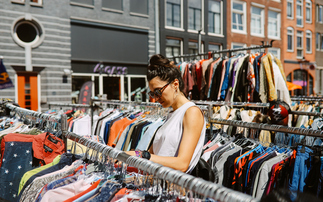Current, powered by GE asks if more sustainable procurement could help drive a step change in businesses' response to escalating climate risks
Global warming is the biggest environmental challenge the world has ever faced. In 2018, the Intergovernmental Panel on Climate Change (IPCC), the UN body made up of global scientists reported that a global temperature rise of 1.5C will be reached between 2030 and 2052 if temperatures continue to increase at the current rate, which is 1C warmer than before the industrial revolution. This increase in global temperature—as a result of a rise in greenhouse gas emissions from industry and agriculture—is already having a measurable effect on the environment, causing rising sea levels, changes in food production and more intense heatwaves. It is also predicted to be one of the greatest causes of animal extinctions this century.
In 2019, climate change activist group "Extinction Rebellion" staged protests in London, UK "to highlight the emergency of ecological collapse" and called on the UK government to transform the economy and society to bring the world to net zero carbon emissions by 2025. Sir David Attenborough also made a statement to the BBC that if we do not take dramatic action within the next decade "we face irreversible damage to the natural world and the collapse of our societies".
What is being done to address climate change?
Greater action is needed by everyone to reduce our impact on the environment. To help bring carbon emissions under control, the UN set a 2030 agenda for Sustainable Development to act as a blueprint to how the world can achieve a better and more sustainable future. It addressed the challenges we face globally and set goals that were adopted by all United Nations Member States in 2015, relating to poverty, inequality, climate, environmental degradation, prosperity, and peace and justice.
With 193 governments agreeing to meet the UN's Sustainable Development Goals by 2030, both the public and private sectors have recognised their urgent, collective responsibility to rethink their approach to sustainability.
According to Carbon Brief, energy efficiency has contributed to cutting demand in the UK by 103 terawatt hours (TWh) between 2005 and 2019, an even greater impact than the switch to renewable sources of energy, which has reduced the demand on fossil fuel-generated energy by just 95TWh.
How can sustainable procurement make a difference to climate change?
Sustainable procurement is an initiative where organisations meet their needs for utilities, goods and services in a way that minimises damage to the environment, while achieving value for money and benefitting not only the company, but society and the economy. By using sustainable procurement practices, businesses can not only "do their bit" for the environment but also support their claims of responsible corporate citizenship and save money in the process, generating positive reputation, stakeholder loyalty and an improved balance sheet. Sustainable practices can include everything from reducing supply chain emissions, improving energy efficiency, and sustainable transport, through to sustainable agriculture.
By introducing a sustainable procurement strategy and setting sustainability targets, organisations can directly balance the business case for the environmental impact of climate change with the cost of investment in green options and how these can deliver value over the long-term.
If a company wants to be recognised for sustainable facilities management, they will also need to follow the procurement processes and rules of BREEAM (BRE Environmental Assessment Method), a global accredited environmental rating scheme for buildings. It uses third-party certification of the assessment of an asset's environmental, social and economic sustainability performance. BREEAM's Green Guide specification contains more than 1,500 specifications used in various types of buildings, with a ranking system graded from A+ to E, where A+ represents the best environmental performance/ lowest environmental impact and E, the worst.
Lighting the way towards a sustainable future
For sustainable procurement managers, lighting offers a fast and easy way to make significant progress towards their targets. Organisations switching from traditional solutions to LED technology will immediately see huge energy and cost savings as an LED bulb uses at least 75 per cent less energy than traditional incandescent, fluorescent and halogen lighting options. For facilities managers concerned with the immediate cost of replacement bulbs, and keeping the status quo running, the significant short-term outlay required to upgrade to LED can be off-putting. However, the long-term ROI is undeniable with LEDs offering longer lifespan, lower maintenance and running costs and greater opportunities for intelligent environmental management. The energy savings gained from switching to LEDs can often enable businesses to recoup their initial investment in just a few years.
LEDs can replace all manner of lighting solutions, from indoor industrial and office lighting, through to outdoor road or parking lamps, retail signage and even specialist horticultural lighting found in greenhouses and vertical farms. By working closely with manufacturers, procurement teams can ensure that their lighting is fully tailored to their needs, whilst ensuring that their sustainability targets are met.
Read the signs
Take commercial signage as an example. In today's highly competitive environment, companies can't afford to compromise on their marketing efforts and must use every inch of their owned real estate to stand out from the crowds. This means that despite the associated energy costs and carbon footprint, companies can't afford not to invest in illuminated signage. However, even this sector can be optimised by approaching it through a sustainable procurement lens.
By working in consultation with a sign maker and lighting experts, companies can ensure that their signage is as sustainable as possible; a number of elements should be taken into consideration as part of the process:
- Design and performance:
Basic considerations will include the size of the sign that needs to be illuminated, the number of signs the business has on site and the size of the company's estate. By working closely with sign makers to use effective product design that maximises the illumination delivered by a minimum number of LED modules, businesses can generate a lower bill of materials (BoM). Good optics are important and advanced technologies now allow sign makers to bend the light in a way that ensures broader light distribution, with better uniformity while reducing energy consumption and light wastage. Without this, sign makers may need to use twice as many lighting modules to achieve the same uniformity of illumination, potentially doubling the product weight and energy consumption, leading to a higher carbon footprint across the estate.
- Quality:
When budgets are tight, businesses may be tempted to look at lowest initial cost for their signage but should instead consider the total lifetime cost compared with the quality of that product. Signs typically only last between five and ten years. Once a product is older than this, many retailers may look to change their branding or signage. However, opting for a cheaper upfront price can prove to be a false economy. Low quality lighting can fail earlier in its lifetime, changing colour and brightness to a point that can damage a brand image, making a building look old and tired before its time. In such cases, customers have little option other than to invest in new signage, leading to more waste going into landfill and higher overall costs to the business.
By using LED modules that are durable and impermeable to moisture and atmospheric pollutants, businesses can save further costs as the LEDs wouldn't degrade, need to be replaced or be maintained with the same regularity as older lighting solutions. Businesses should also look to pay extra attention to the drivers of signage lighting solutions and ensure that there are fewer points of potential failure in the power supply, as this is the most common cause of failure, materials wastage (and associated carbon footprint) and additional cost after installation issues. For example, by ensuring the maximum case temperature can bear 10 per cent more than other solutions (i.e. 60⁰C vs 50⁰C), Current by GE's solutions can enable customers to potentially double the lifespan of a power supply when run at that maximum temperature.
- Lifespan:
At the end of a sign's life, lighting modules will need to be refurbished or thrown away. The fewer products that are thrown into landfill, the better green rating a company can achieve, and for every percentage point of energy consumption that businesses can eliminate, the stronger the bottom line will be. By using fewer lighting modules and less energy overall while reducing the risk of failure, and resulting maintenance costs, combined with a longer lifespan that delays the need to replace or refurbish a sign, the total cost of ownership can be significantly reduced along with attributed carbon emissions. While the initial investment for businesses may be higher as new signs must be designed and built, in the long run it is likely to be a much more sustainable and effective solution.
The next generation of intelligent lighting solutions
With many businesses having already reduced their costs by 30 to 40 per cent through switching to LED lighting solutions and following sustainable procurement best practice, many are now asking, "what next?" Adding a layer of intelligence allows building managers to take a far more proactive approach to environmental control and shave more savings from their energy bills. Current by GE's lighting fixtures are able to integrate the company's Daintree wireless system, which collects data on illuminance, temperature, occupancy, and humidity to provide more insight than ever before into how different areas of a space are used. Sensors to monitor other environmental factors like noise and CO2 can also be added to the same data network, providing even more comprehensive insights that can save businesses a potential 20 to 30 per cent in energy costs.
Technology innovations of this kind have the potential to make a huge difference in the fight against global warming, enabling businesses to access smarter, more efficient systems that can help to minimise our impact on the planet.
To find out more about how Current, powered by GE, can help you reach your sustainability goals, please visit: www.currentbyge.com.






